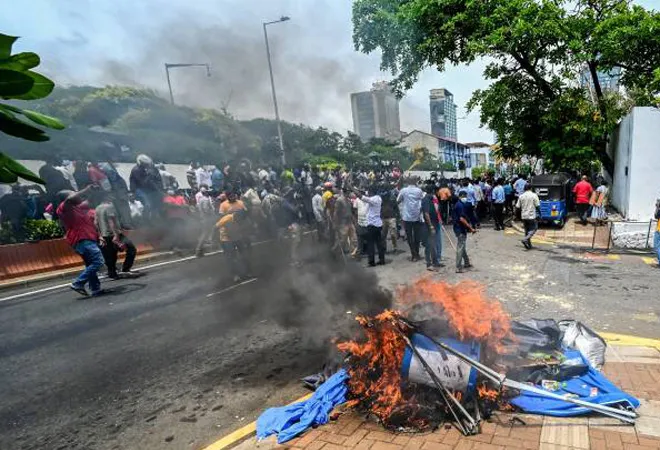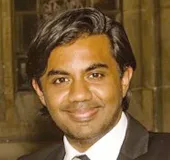 This piece is part of the series, The Unfolding Crisis in Sri Lanka.
This piece is part of the series, The Unfolding Crisis in Sri Lanka.
In autocracies, where rulers are above the law, the saying appears to be true: “
For my friends, everything; for my enemies, the law”. In Sri Lanka, where the powerful Rajapaksa family expanded its autocratic control, that phrase must be revised: “For my family, everything; for my enemies, the law.” Sri Lanka, Asia's oldest democracy is struggling under the autocratic rule of the Rajapaksa family as President continues to hold power despite mass protests.
Mahinda Rajapaksa, the former Prime Minister, however, was compelled to step down on 9 May 2022.
As the economic crisis worsened over the last couple of months, protests began to take place all around the island nation. The Sri Lankan people began to realise that the power ultimately rested in their hands. However, the peaceful protestors were
beaten by the former Prime Minister’s supporters and the protest site, ‘GotaGoGama’, was destroyed. Studying the ground reality, Senior Political Scientist
Jayadeva Uyangoda correctly identified the protest site as a ‘
secular shrine of democracy’, further
explaining that the “political wind that blows through the ‘GotaGoGama’ of the Galle Face, Colombo, is truly refreshing. That is perhaps why so many citizens continue to visit the protest site to energize themselves and experience an inner transformation as citizens. This site must remain as a secular shrine of democracy’s regeneration in Sri Lanka.”
The Sri Lankan people began to realise that the power ultimately rested in their hands. However, the peaceful protestors were beaten by the former Prime Minister’s supporters and the protest site, ‘GotaGoGama’, was destroyed.
The thugs sent by the former Prime Minister attacked a ‘secular shrine’ and the retaliation was swift, viral, and brutal. The thugs were beaten back, and a few were killed including a Member of Parliament. The Opposition leader was chased out of the protest site and hospital workers refused to treat the regime’s supporters. For the second time in five weeks, President Gotabaya Rajapaksa declared a
state of emergency in Sri Lanka. The sheer use of police force was witnessed as thousands of peaceful protestors were baton-charged and tear-gassed. The government’s intention of declaring a state of emergency remains questionable. Although it was
explained as a measure to ensure public safety and to continue supplying essential goods and services, it was clear that the underlying intention was to dismantle the island-wide protest using security forces.
There is a danger in using brute force and bringing the military to the forefront. Sri Lanka is a fragile society rife with ethno-religious tensions from its past bloody insurrections and civil war. The short term use of force could snowball into a full-fledged social agitation. Public anger could grow rampant and further prolong the political-economic stability. Finally, given its military past, Sri Lanka could quickly move toward a military state closer to the Myanmar model. The regime has used the national security and Prevention of Terrorism Act (PTA) as a pretext to justify its suppression and the use of force. The US ambassador to Sri Lanka,
Julie Chung, and many other diplomats raised concerns about the state of emergency declared to crush the peaceful protest.
Sri Lanka is facing a clear ‘Arab Spring’ moment triggered to overthrow the autocratic rule, highlighting the rampant corruption and rising poverty.
Protests at the President’s house and Galle Face had a ripple effect on the entire island. The government labelling the protesters as extremists and the police
shooting in Rabukkana and attacking peaceful protestors at the protest site have only aggravated the situation.
Hundreds of lawyers are appearing on behalf of the protesters. The regime’s
immediate family members and financiers are fleeing the country as
their properties are being burnt down.
The government labelling the protesters as extremists and the police shooting in Rabukkana and attacking peaceful protestors at the protest site have only aggravated the situation.
To quell this anarchy, the President should listen to the protestors and step down. The crisis could get out of control and many innocent lives will be lost with the military at the forefront. Sri Lanka’s ugly past could return if President Gotabaya does not step down and the Parliament does not immediately appoint a new leader as the nation's interim government to steer the nation to stability. Each hour is crucial, and Gotabaya should accept the reality.
On 11 May, the
President addressed the nation and explained three solutions to stabilise the crisis instead of resigning as the President: First, to appoint a new Prime Minister from the Parliament; second, to amend the 20th Amendment curtailing the executive powers and reverting to the previous amendment to empower the Parliament; and finally, to accommodate the new regime by abolishing the executive presidency. The process put forward by the President promises a power transition in which the new prime minister will require the support of the Parliament and the public, including the protestors. There will be a considerable burden on the new Prime Minister to function under the President for some time since the protestors have identified Gotabaya’s resignation as a primary condition. Will President Gotabaya hand over national security and defence to the new prime minister? How will the new prime minister prosecute Rajapaksa for corruption and human rights abuse highlighted by protestors, when the President is from the Rajapaksa family? How will the interim government win the trust of the public that it has lost? These are a few vital questions and challenges that the new
Prime Minister Ranil Wickremesinghe will have to confront.
Economic Crisis, the IMF, and China
The Rajapaksa government proved its inability to function even after appointing two cabinets in the previous month, followed by Prime Minister Mahinda Rajapaksa’s resignation. The
President admitted his policy blunders and looked forward to a pragmatic reform to satisfy the protestors. At the same time, protestors do not want to retract the critical demand made for the President to step down. With the
worst economic crisis since its independence in 1948, the nation has defaulted, with its foreign-currency debt rating falling to “selective default”. Finance Minister Ali Sabry alerted the Parliament that the usable foreign exchange reserves had dropped
below US $50 million. Food inflation has soared over 30 percent in March. A significant fuel shortage means that power outages will continue for long hours and petrol pumps will run dry. The adverse effects of the economic crisis will be borne by the low- and middle-income households.
The Sri Lankan government has approached the International Monetary Fund (IMF) for a rapid finance instrument and a bridge loan to stabilise the economic crisis. Securing a loan from the IMF would require Sri Lanka to implement a debt restructuring. China’s
rejection of restructuring debt is a concern; Sri Lanka owes Beijing US$6.5 billion. Sri Lanka would lose out on a lot of time if its debt restructuring depends on support from the Paris Club—an IMF programme—and Chinese participation if China drags on the process. Confirming the Chinese reservation, the former Cabinet spokesman Nalaka Godahewa said the government’s “
only concern is the position of China”.
The Sri Lankan government has approached the International Monetary Fund (IMF) for a rapid finance instrument and a bridge loan to stabilise the economic crisis. Securing a loan from the IMF would require Sri Lanka to implement a debt restructuring.
Many nations have come forward to assist Sri Lanka. India has been assisting Sri Lanka immensely to stabilise the economic crisis. Akhil Bery, from Asia Society Policy Institute,
recommend a Quad humanitarian relief assistance to Sri Lanka. It is an opportunity for India and the US to reduce China’s influence on Sri Lanka and strengthen the ‘
partnership with New Delhi by supporting its central foreign policy objective of maintaining regional primacy and counteracting Chinese encirclement’. Sri Lanka’s China bandwagoning foreign policy requires immediate recalibration. This is an opportunity to balance Sri Lanka’s foreign policy to be within the global rules-based order and to inculcate more objective and prudent financial standards, moving away from Chinese opaque, high-interest loans, and unprofitable projects. The recalibration will enable Sri Lanka to access funding from multiple channels, including QUAD nations. Sri Lanka’s commitment to the
Indo-Pacific has been unclear due to its tilt toward China.
Sri Lanka has an opportunity to re-embrace the democratic values lost due to autocratic manoeuvres in the past and re-democratise the nation’s processes and institutions. For this, Sri Lanka requires immediate stability with all of the Rajapakas’ stepping down and allowing a new interim government supported by the protestors to stabilise until elections in a few months could take place to appoint the new members to the Parliament for an overall ‘system change’. Sri Lanka would have to make improvements in democratic and human rights space if it hopes to re-enter the folds of the liberal world order and ask for global assistance to iron out its economic crisis.
The views expressed above belong to the author(s). ORF research and analyses now available on Telegram! Click here to access our curated content — blogs, longforms and interviews.



 This piece is part of the series,
This piece is part of the series,  PREV
PREV


